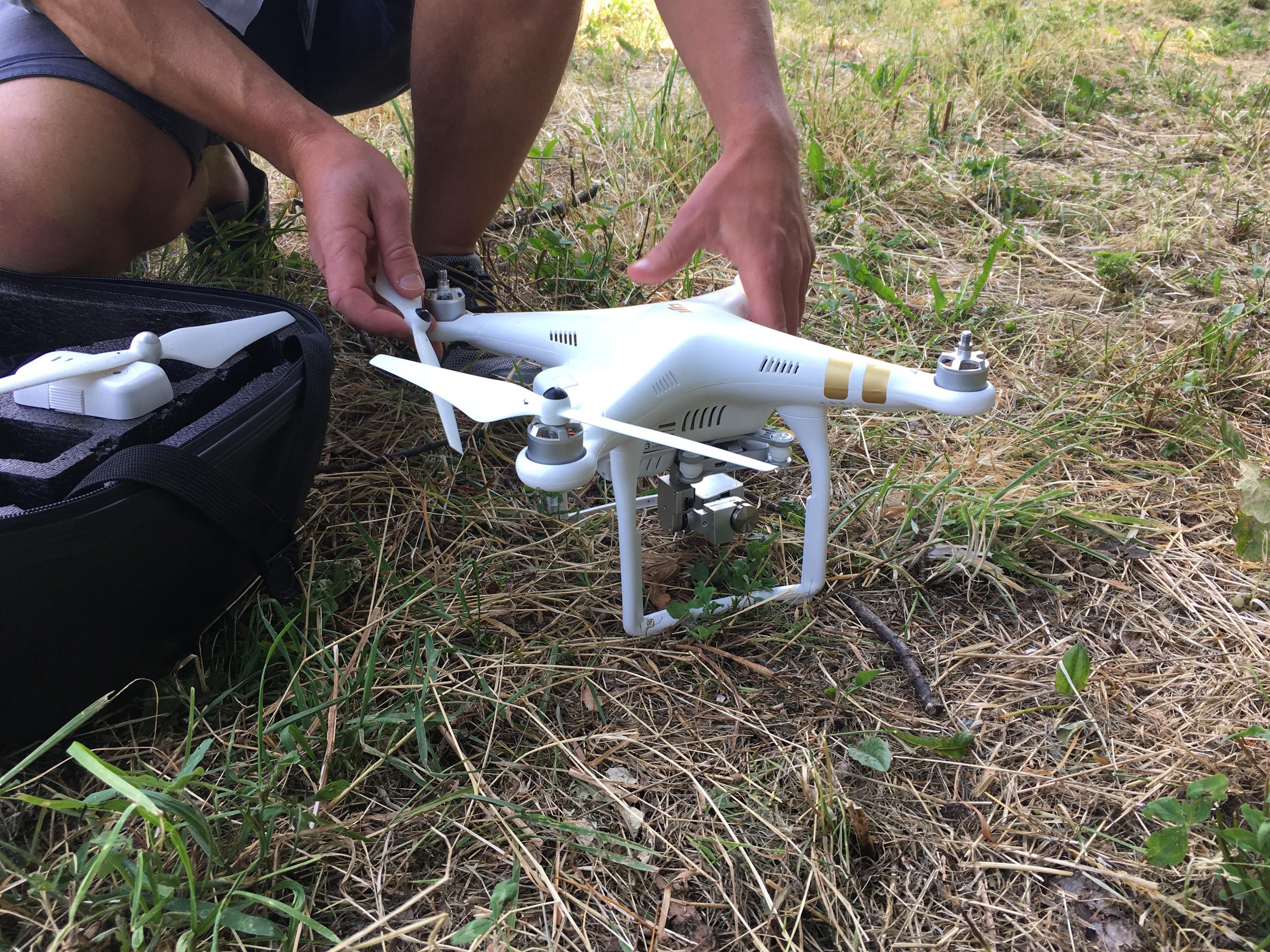
How drones are shedding their military image and moving into cities
As commercial drones become a greater fixture in our everyday lives, their association with their military ancestors will have to be set aside to foster better acceptance, writes international relations practitioner Francesco Bortoluzzi of swissnex Boston.
The origins and evolution of drone technology have been a central question in the curation of Aerial Futures: The Drone FrontierExternal link at swissnex BostonExternal link – an event series that aims to connect the Swiss drone ecosystem to the United States. In our ongoing exploration, we surveyed experts in Boston’s research and technology scene to help us understand the origins of commercial drones.
A history of uneasiness and ambiguity

Today’s drones trace their roots to the beginning of the aviation age, when any aircraft in the sky struck both wonder and worry in the hearts of people around the world. During the Second World War, when air power started to play a decisive role in combat, drones were first developed as radio-controlled aircraft for pilotless bomb delivery (later developed into rockets) and air force training with devices such as the UK’s “DH.82B Queen Bee”. The term “drone” itself was probably inspired by semantic proximity to this ancestor.
Uneasiness around drones’ military origins never went away, especially as they quickly became a means of aerial reconnaissance thanks to technological advancements spearheaded by the US. Nonetheless, the first operationally meaningful use of drones in the battlefield was successfully carried out by Israel against Syria in 1982. This caught the attention of many countries, spurring them towards significant investments in developing sophisticated drones like the Predator, which was retired in 2018.
Today, military drones serve three main purposes: covert tactical strikes, combat surveillance, and reconnaissance. For reconnaissance purposes, small drones like the commercial ones currently available are used, which only perpetuates the ambiguous identity of drone technology.
Technological acceleration
Widespread availability of commercial drones has taken off in the last couple of decades, as small parts electronics manufacturing became available on a large enough scale.
“Smartphones are often indicated as the driving factor in the rise of commercial drone technology,” Andrew J WeinertExternal link, a researcher in the Homeland Protection and Air Traffic Control Division at MIT’s Lincoln Laboratory, told swissnex Boston.
In the US alone, the commercial drone market surged exponentiallyExternal link from $40 million (CHF39.3 million) to $1 billion between 2012 and 2017, contributing almost $40 billion to the country’s GDP. This was largely due to the incredible speed at which drone technology made its way from research labs to the commercial marketplace.
According to Weinert, the development of the drone market was not well anticipated by the aviation community. Historically, he says, the development of commercial drone technology has had the industry flying by the seat of its pants.
“In some cases, we’ve seen tech transfer from research publication to product in about two years. We’re not talking 5-10 plus years anymore, as with larger manned aircraft.”

More
Curious about drones? Here are the basics
Applications from A to Z
Just as remarkable as the industry’s rapid development is the extent of innovation in drone applications. A 2016 study conducted as part of NASA’s UTM projectExternal link found 135 potential drone applications across 16 leading commercial sectorsExternal link. As explained by one of the authors, MIT graduate researcher Parker VascikExternal link, “What we saw was that the biggest applications by far, were in imaging for precision agriculture, and inspections for heavy industries like railway lines, bridges, powerplants, smokestacks, and wind turbines.”
Modern commercial drones were already well-suited for these applications, and existing regulations allowed for them, Vascik says, especially since they tended to be conducted within visual-line-of-sight and sparsely populated areas. This resulted in the drone industry quickly becoming very large and concentrated around few big manufacturers, such as PrecisionHawk and DJI.
However, as Vascik notes, even though today there are fewer small start-ups that make aircraft, “there are many different companies operating with commercially bought drones, often with modifications to fulfil operational needs”.
The applications of drone technology continue to grow, and today include aerial photography, sensing, surveillance, communications, transportation, delivery, and atmospheric and earth sciences.
Regulation and public acceptance
Humanitarian drone applications shed light onto one of the greatest challenges looming large on the horizon for drones: public acceptance and aerial traffic management regulating their usage. In humanitarian contexts, the confusion between military and commercial drones is probably the most prominent, especially when paramilitary groups repurpose commercial drones for asymmetrical warfare.
“Identification is a central issue here: it’s extremely difficult to tell drones apart in the sky,” says Faine GreenwoodExternal link, a researcher with the Harvard Humanitarian Initiative Signal Program on Human Security and Technology. How can refugee populations, for instance, tell the difference between a weaponised drone and one airlifting food and medical supplies?
“Ideally, everyone should do a better job of appropriately marking their drones for identification,” suggests Greenwood, adding that society at large might feel better about new technologies like drones if they could easily identify those conducting military operations versus those engaged in humanitarian efforts.
With the growth of commercial drone applications, we may start to see drones flying where they have never flown before, like above densely populated cities, which makes aerial traffic management a priority. Would we be willing to accept drones flying back and forth across a beautiful skyline? And as drones grow larger, would we learn to ignore increased noise pollution? What about the risk of drones falling out of the sky?
“The way airspace is used and the way the public interacts with it is changing,” says Weinert. “Studies are currently getting close to figuring out risk mitigation protocols between manned aircrafts and drones, while the drone vs drone dynamic will soon be the focus.”
The main challenge, though, isn’t technology; it’s policy.
“The big question that needs clarification is: who actually owns the airspace, especially at low altitudes, and who is responsible for managing operations? Is it the owner, the municipal, or the federal government?” Vascik says.
Different countries around the world are devising and implementing different regulatory frameworks to answer these questions; only time will tell which places will be most welcoming to this technology and where we will see the first drone highways in the sky.
One thing is certain, though: aviation is inherently a global technology field and, as these issues begin to become resolved, it won’t take too long for this new frontier to bring an aerial future to every horizon.
The views expressed in this article are solely those of the author, and do not necessarily reflect the views of swissinfo.ch.
swissinfo.ch publishes op-ed articles by contributors writing on a wide range of topics – Swiss issues or those that impact Switzerland. The selection of articles presents a diversity of opinions designed to enrich the debate on the issues discussed.
Aerial Futures: the Drone FrontierExternal link is an ongoing event series created and curated by swissnex Boston, aimed at exploring the changes to policy and society that accompany the growing adoption and implementation of professional drone technology. swissinfo.ch’s dossier contains stories published on events and topics corresponding to the Aerial Futures series, in collaboration with swissnex Boston. You can follow the series on social media using the #DroneFrontier External linkhashtag.

In compliance with the JTI standards
More: SWI swissinfo.ch certified by the Journalism Trust Initiative
















![The four-metre-long painting "Sonntag der Bergbauern" [Sunday of the Mountain Farmers, 1923-24/26] had to be removed by a crane from the German Chancellery in Berlin for the exhibition in Bern.](https://www.swissinfo.ch/content/wp-content/uploads/sites/13/2025/12/01_Pressebild_KirchnerxKirchner.jpg?ver=917ecbf2)















You can find an overview of ongoing debates with our journalists here . Please join us!
If you want to start a conversation about a topic raised in this article or want to report factual errors, email us at english@swissinfo.ch.